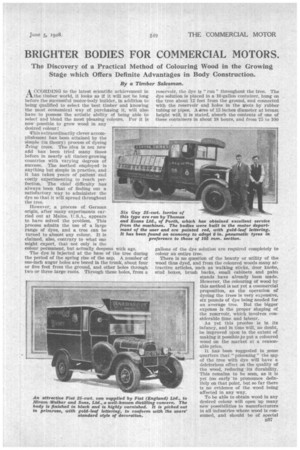BRIGHTER BODIES FOR COMMERCIAL MOTORS.
Page 63

Page 64

If you've noticed an error in this article please click here to report it so we can fix it.
AccoRDINa to the latest scientific achievement in the timber world, it looks as if it will not be long before the successful motor-body builder, in addition to being qualified to select the best timber and knowing the most economical way of purchasing it, will also have to possess the artistic ability of being able to select rind blend the most pleasing colours. For it is now possible to grow wood in any desired colour !
This extraordinarily clever accomplishment has been attained by the simple (in theory) process of dyeing Aving trees. The idea is not new and has been tried many times before in nearly all timber-growing countries with varying degrees of success. The method employed is anything but simple in practice, and it has taken years of patient and costly experimenting to reach perfection. The chief difficulty has always been that of finding out a satisfactory way to administer the dye so that it will spread throughout the tree.
However, a process of German origin, after many experiments carried out at Maine, U.S.A., appears to have solved the problem. This process admits the use of a large range of dyes, and a tree can beturned to almost any colour. It is claimed, also, contrary to what one might expect, that not only is the colour permanent, but actually deepens with age.
The dye is injected at the base of the tree during the period of the spring rise of the sap. A number of one-inch augur holes are bored in the trunk, about four or five feet from the ground, and other holes through two or three large roots. Through these holes, from a reservoir, the dye is " run " throughout the tree. The dye solution is placed in a 16-ga1lon container, hung on the tree about 12 feet from the ground, and connected with the reservoir and holes in the Vots by rubber tubing or pipes. A kite of 15 inches diameter at breast height will, it is stated, absorb the contents of one of these containers in about 18 hours, and from 75 to 100 gallons of the dye solution are required completely to colour an entire tree.
There is no question of the beauty or utility of the wood thus dyed, and from the coloured woods many attractive articles, such as walking sticks, door knobs, stud boxes, brush backs, small cabinets and palm stands have already been made. However, the colouring of wood by this method is not yet a commercial proposition, as the operation of dyeing the trees is very expensive, six pounds of dye being needed for an average tree. But the bigger expense is the proper shaping of the reservoir, which involves considerable time and labour.
As yet this procss is in its infancy, and in time will, no doubt, be improved upon to the extent of making it possible to put a coloured wood on the market at a reasonable price.
It has been suggested in some quarters that "poisoning" the sap of the tree with dye will have a deleterious effect on the quality of the wood, reducing its durability. This remains to be seen, as it is yet too early to pronounce definitely on that point, but so far there is no evidence of the wood being affected in any way.
To be able to obtain wood in any desired colour will open up many new possibilities to manufacturers in all industries where wood is consumed, and should be of special interest to all concerned in the construction of elegant motor coaches.
When coloured wood is available in sufficient quantity and at a reasonable price, it should be of enormous advantage to the motor-body builder, and at once lower the cost of bodywork. One obvious advantage of using this material is that it will save the cost of both time and labour which it is now necessary to spend on staining wood. Coloured wood will only need polish or varnish, which can be applied direct to the smoothed or planed surface.
With the advent of this extremely novel method of production, vehicle owners also may look _forward to a reduction of maintenance costs, especially in passenger-carrying vehicles, where smartness of appearance is essential, and where paint and stain are considerable items. It will no longer be necessary for such vehicles to be so often idle for, perhaps, weeks at a time while being "done up," for if they are built of coloured wood which is coloured throughout, no amount of hard wear can knock the " paint " off, presenting that old and worn appearance which we are so used to seeing. All classes of vehicle .built of the coloured material will certainly retain their " newness " for a far longer period than is the ease at the present time.
The idea of colouring living trees sounds fantastic, but is now an accomplished fact, and when the wood thus produced can be commercialized it may start all sorts of fashions in the embellishment of motor-vehicle • bodies of various types.
" Brighter Bodies" is the motto for the future I




















































































































